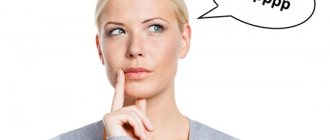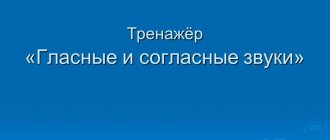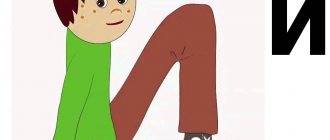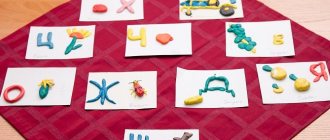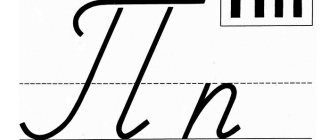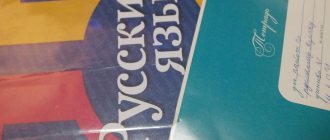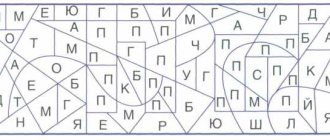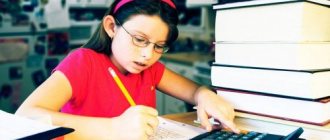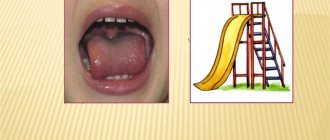Purpose of the lesson: we study the letter Y, the formation of reading skills, the development of speech skills, the improvement of phonemic awareness, the basics of elementary graphic skills.
Tasks:
- introduce the preschooler to the letter Y and the correct pronunciation of the sound;
- teach how to write the printed letter Y in squares;
- to generate interest in learning poems and riddles.
Name what is shown in the pictures below:
Kettle
Parrot
Yogurt
Yogi
- Please listen to the words (emphasize the last sound in your voice): mine, yours, wild, kind, smart.
- What sound is there in all these words?
- What sound is there in both the word PARROT and the word MIKE?
- At the beginning, at the end or in the middle of a word is the [Y] sound in the word PARROT? — MIKE? - GIVE? — AIBOLIT?
When we pronounce the sound [Y], the tip of the tongue is behind the lower teeth, and the back of the tongue rises to the palate. Say: YYY. The back of the tongue rises to the palate and prevents air from freely leaving the mouth when we pronounce the sound [Y].
- Vowel or consonant sound [Y]?
- Voiced or voiceless?
- Why?
- Look at the letter Y. What letter does it look like?
The letters are similar, but the sounds are completely different: [I] is a vowel, and [Y] is a consonant sound.
Repeat: BUNNY. What is the first syllable in this word? What is the second syllable in this word?
Similarly - with the words MIKE, SMART, STUPID, TRAM, AIBOLIT.
Read the words: my, may, smart, kind, red, hero, bunny, stupid, strong, green, funny, tram -wai.
Assignment: printed letter Y for preschoolers
Examine the letter Y. Sew the letter Y in the air and once in the notebook, carefully in the cells with a simple pencil or ballpoint pen.
In cases where the child is asked to write a whole line of a letter, syllable or word, the adult gives a writing sample at the beginning of the line. If a preschooler has difficulties, then an adult can draw two approximate lines, or put reference points that the child will connect with lines, or write the entire letters, and the child will simply circle them in a different color. Calligraphy should not be required at this stage of training.
Print
Exercises to strengthen and develop the speech apparatus
Often, a child pronounces sounds incorrectly because his speech apparatus muscles are poorly developed. Speech therapists offer exercises aimed at strengthening this muscle group. You need to start doing them from the age of 3-4 years, so that by the age of 6-7 years the child does not have any problems with speech.
- Exercises to strengthen the muscles of the tongue help pronounce the letters “c”, “ch”, “t”, “r”, “sh”, “zh”.
- “Sting” - tense your tongue as much as possible, stick it out and stay in this position for as long as possible.
- “Spatula” - place the tongue on the lower lip.
- “Bowl” - open your mouth, stick out your tongue, do not touch your teeth, stick it back.
- “Pendulum” - open your mouth, stick out your tongue, tense, and move left and right.
- “Horse”, “turkey” - the baby should imitate the clatter of hooves, as well as the cry of a turkey (bl-bl-bl).
- Exercises to strengthen the root of the tongue help to correctly pronounce the sounds “g”, “k”, “x”.
- slight cough;
- imitation of sounds when gargling;
- pronunciation of the vowels “a”, “i”, “e”, but sharply, abruptly.
- Correct closing of the lips helps to pronounce the sounds “b”, “m”, “p”.
- Squeeze the pencil between your lips and describe a circle in the air with it.
- Squeeze a bean or seed with your lips and then sharply spit it out.
- Show how a horse snorts.
- Imitation of drum sounds - boom, bam.
- Cheek training.
- Take turns puffing out your cheeks.
- Puff out your cheeks and imitate chewing food.
- Roll air from one cheek to another.
Fine motor skills help in speech development. Massage your baby's palms regularly. You can use soft brushes, balls, and say jokes for this. Applications, stringing of beads, modeling from plasticine or salt dough are great for developing fine motor skills.
Tale about the letter Y
What do you know about yoga?
“What do you know about yogis?” - that was the name of the book that Mouse the mouse found in the garden. On the cover there was a picture of a naked guy - a yogi, who, as if nothing had happened, was lying on nails sticking out of the board. In other pictures, the same yogi simply stood with his bare feet on hot coals or sat frozen in a block of ice. In addition, Mouse read that yogis can go for months without eating or drinking. - Need to try! - decided Mouse. “I can imagine what will happen when mom opens the refrigerator, and I’m sitting there frozen and smiling. Or dad opens the stove, and I sit there on the coals and say: “What, I’ve never seen yoga, or what?”
To begin with, he hammered nails into the board and just lay down on them, when he immediately jumped up and started yelling at the whole garden:
- Ohhhhh!!!
He ran home, took out iodine and began to smear the nail scratches on himself. And iodine burns! Mouse smears, groans, and thinks: “I’ll throw this book to the cat.” Let him be a yogi now.”
(G. Yudin)
Cards "Opposites"
Here you can download educational cards “Opposites”. They will help the child, in the form of a game, learn to find opposite concepts, as well as expand his vocabulary. You will find cards with images of pairs of objects in the surrounding world, natural phenomena, actions and actions of people, which are compared and contrasted according to some specific feature or quality: shape, size, color, property, behavior.
There are different versions of cards for comparing opposites and they cover a lot of concepts, both simple (big-small, far-close) and complex (empty-full, full-hungry). Choose the one that suits your child and practice while playing.
Also, to conduct classes on the topic “Opposites,” you can download and use coloring pages with tasks, as well as poems about opposites for children.
Riddles for children starting with the letter J
When it boils, steam comes out, and it whistles and bursts with heat, the lid rattles and knocks. - Hey, take me off! - shouts. (Kettle)
Amazing carriage! Judge for yourself: The rails are in the air, and he holds them with his hands. (Trolleybus)
In a woolen clearing, a thin-legged animal dances. A stitch creeps out from under a steel shoe. (Sewing machine)
It might break. It can be boiled, If you want, it can turn into a bird. (Egg) Tell me, who is so afraid of things, Like a dog is afraid of a stick, Like a bird is afraid of a stone? (Lazy person)
I run to my mother river and cannot remain silent. I am her own son, and was born in the spring. (Creek)
He produces sheets of Wide Latitude. Supported by strong stems One hundred rough, tenacious fruits: If you don’t get around them, you’ll find them all on yourself. (burdock)
He grew up in a field angry and prickly, There were needles in all directions. (burdock)
I am always friendly with the light. If the sun is in the window, I run along the wall from the mirror, from the puddle. (Sunny bunny)
There is a button on the head, a sieve in the nose, one hand, and even that on the back. (Kettle)
English alphabet - Printable cards with transcription - How to use:
Download the English alphabet as attachments - printable cards from the little fox Bibushi, cut along the orange lines so that the cards are rectangular, and start practicing with your children. Each card contains a printed letter (capital and uppercase), English and Russian transcription, a picture and an English word that begins with this letter, as well as a transcription of this word.
You can download ALL the English alphabet cards in ORIGINAL size in the attachments at the bottom of the page
The English alphabet, like the Russian one, is easier for children to remember when it is presented in pictures. Indeed, in this case, visual memory actively works. Also, such learning of letters is also effective due to the associations that arise in the child during the process of memorization. After all, each letter will be associated with a specific picture. The effectiveness of this method has long been proven by scientists.
So, now you can view and download the English alphabet - printable cards that we have lovingly ))) developed for you!
Cards No. 1 - English letters Aa (hey), Bb (bi), Cs (si), Dd (di), words - Apple (apple), Baby (baby), Cat (cat), Dog (dog).
Cards No. 2 - English letters Ee (and:), Ff (ef), Gg (ji:), Hh (eych), words - Egg (eg), Flowers (flowers), Girl (gyo:l), House (house ).
Cards No. 3 - English letters Ii (ay), Jj (jay), Kk (key), Ll (el), words - Ice (ice), Juice (juice), Key (ki:), Letter (le*te) .
Cards No. 4 - English letters Mm (um), Nn (en), Oo (ou), Pp (pi:), words - Money (ma*ni), Nurse (ne:s), Orange (o*ringe), Pig (pig).
Cards No. 5 - English alphabet. Letters Qq (Q), Rr (a:), Ss (es), Tt (ti:), words - Gueen (Q:), Rabbit (ra*bit), Smile (smile), Table (table).
Cards No. 6 - Letters of the English alphabet: Uu (yu:), Vv (vi:), Ww (double u:), Xx (ex), words - Umbrella (ambre*le), Vegetable (ve*jitable), Window ( uy*ndow), Xerox (zi*erox).
Card No. 7 - English letters: Yy (yay), Zz (zed), words - Yogurt (e*get), Zebra (zi*bre).
English alphabet - Uppercase and block letters - Printable poster
We have also developed for you an educational poster “The English Alphabet - Capital and Printed Letters” so that children can remember English letters not only in print, but also in capital letters. After all, the handwriting of many letters is very different from their printed form. And so many children have difficulties in this regard.
To make it easier for you to learn the English alphabet, download the poster, print it on colored paper, and then give it to your child to memorize.
English Alphabet Poster - Uppercase and Block Letters
You can download the poster in its original size for printing in the attachments at the bottom of the page.
Letters of the English alphabet - Printable cards for children
Here you can download the letters of the English alphabet, print cards with capital and block letters and test your child to see how well he remembers the letters from the poster. To do this, you need to cut out the printed cards and divide them into two piles - one with capital letters and the other with block letters.
You can also modify the activity and ask the child to put all the cards in pairs - printed and capital. In this case, you need to check the completion of the task after the child has sorted all the letter cards of the English alphabet into pairs.
You can download all the cards with letters in the attachments
PRINTED letters of the English alphabet - Flashcards
English block letters - Aa, Bb, Cc, Dd, Ee, Ff, Gg, Hh
Printed letters of the English language - Ii, Jj, Kk, Ll, Mm, Nn, Oo, Pp.
Cards with English letters - Qq, Rr, Ss, Tt, Uu, Vv, Ww, Xx, Yy, Zz
CAPITAL letters of the English alphabet - Printable cards
Funny poems about the letter J for children
Iodine is good, iodine is not evil. In vain you shout: “Oh-oh-oh!” — I just saw a bottle of iodine. Iodine sometimes burns, of course, but a wound smeared with iodine will heal faster. (V. Lunin)
Play, bunny, play with me. The bunny answers: “I can’t, I’m sick!” Oh-oh-oh, poor thing! (E. Blaginina)
“Oh-oh-oh!” said OH-OH. - I, my friend, am completely sick! - Go for a walk! All will pass! - said AY-AY. (G. Vieru)
A yogi will never say: “Oh!” "Oh oh oh!" - the yogi will not shout. Young man, control yourself! Old, be like young! (V. Berestov)
I am on the tails of birds and animals: Here is an ermine, here is a sparrow. (E. Grigorieva)
At the “I Brief” station We were greeted with a riddle: “Read, dare and guess - How, without getting up from your seat, can you turn a tram into many trams? ...What should you skip so that you can turn a bunny into a stutterer?” One of us thought about the answer for about three minutes and answered, “Erase the hook above the letter “And short.” (S. Marshak)
The ant found a blade of grass and had a lot of trouble with it. He carries it home like a log on his back... He bends under the burden. He is already crawling with difficulty. But what a good house the Ants are building! (3. Alexandrova)
Talking ABC - poster for learning the alphabet at home
We have prepared for you a review of the most interesting and fascinating alphabet posters. Choose a poster where the voice pronounces the letter and sound
It is important that the child understands the difference between them. Be patient, support the child in everything, help him
Talking ABC Expert. This poster contains letters, poems, songs, and the voiceover is clear and understandable.
ABC. Farm and zoo. Here the child will find fairy tales, letters, numbers, geometric shapes, animal names. The poster is bright, engaging, and the sound is clear and loud.
- Poster Pushkin and Russia. ABC. The canvas depicts characters from the works of Alexander Sergeevich Pushkin, they read poetry, professional voice acting is used. The buttons respond well to pressing and have an auto-off function.
- Safety poster. ABC. – the poster introduces children not only to letters and sounds, but also to the rules of the road. Very colorful, useful and durable.
- ABC of child safety. Connoisseur. The poster teaches useful and necessary things in life - politeness, correct behavior and, of course, the alphabet. There is a knowledge test function and musical accompaniment.
Study Materials
Journey of the letter I
One day the letter I decided to travel to summer. She walks along, interested in everything.
— What is the name of this exquisite flower?
- Yes, this is Ivan da Marya.
— What wonderful birds’ voices do I hear?
— These are the orioles performing their famous songs.
- What kind of wonderful tree spread its rich, emerald branches?
- This is willow, the queen of spreading trees.
- Whose holiday is being celebrated today, not far away, in the poultry yard?
- It's the turkey's name day.
— What are those cheerful children doing in bright outfits?
— They are playing an interesting game.
All questions asked by the letter I were answered by... who do you think? Two brothers: June and July.
The letter I is happy. He walks, smiles, looks sideways: “It’s good here and it’s good there. My glorious kingdom is warm.”
Author of the story: Iris Review
How to teach the alphabet in 1st grade
Children begin to learn letters in kindergarten, so in first grade the material is consolidated. Letters are taught not as they are located in the alphabet, but taking into account the phonetic features of letters and sounds.
- Lessons begin with the study of vowels: A, U, O, E, I, Y.
- The next topic is devoted to sonorant consonants - M, L, R, N, as well as the letter Y.
- Then they study consonant letters that form pairs - hard-soft, voiced-voiceless: G-K, D-T, B-P, Z-S, V-F.
- Then they learn the vowels that sound after the soft sign and consist of two letters: E, Yo, Yu, Ya and the soft sign.
- There comes a turn of hissing consonants: X, Ch, Shch, Ts and a dividing solid sign.
There is no single methodology for learning letters in 1st grade. The sequence varies depending on the program in which the class is taught, as well as the methodology approved at the school. There are teachers who have developed their own methodology. The standard order for learning letters is as follows:
- Vowels that sound unambiguous;
- Simple consonants;
- Paired consonants;
- Complex letters.
